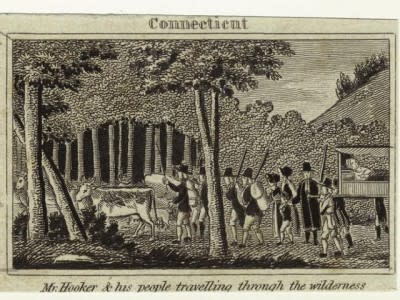The debate over Connecticut as the Constitution State
The state of Connecticut is proudly called the Constitution State and it celebrates a big anniversary today. But is the “constitution” celebrated by Connecticut really a constitution?
The question has been debated within Connecticut for decades, and it has nothing to do with the U.S. Constitution. Although the Connecticut Compromise at the 1787 convention in Philadelphia was a critical part of the process of agreeing to and ratifying the U.S. Constitution, Connecticut is celebrating an event that happened in 1639.
On January 14, 1639 (in the old Julian calendar), the residents of three Connecticut towns approved a list of rules for running local government called the Fundamental Orders. Most historians agree the Fundamental Orders are significant, but the state of Connecticut decided in 1959 to call itself the Constitution State based on the premise that the Fundamental Orders were the first constitution in North America.
That had been issue of debate among historians for decades well before 1959.
Link: Read the Fundamental Orders
The residents of Windsor, Wethersfield and Hartford were originally from Massachusetts and they received permission from state authorities to self-govern in 1636. Roger Ludlow, who was the only attorney in the Connecticut area, is believed to have written most of the Fundamental Orders.
Comments by another figure, the Reverend Thomas Hooker, in a sermon in 1638 set the stage for the Fundamental Orders. At a meeting of the three towns, Hooker said, “the foundation of authority is laid in the free consent of the people.” Hooker also believed that people should appoint their own officials “under God’s allowance” and public officials had powers limited by the people who granted them office.
The Fundamental Orders document has a structure that is similar to a constitution. There is a preamble and a list of powers about local government, taxation and voting rights.
The preamble states that the in area where residents live, “the word of God requires that to maintain the peace and union of such a people there should be an orderly and decent Government established according to God, to order and dispose of the affairs of the people at all seasons as occasion shall require.”
The concepts underlying the Fundamental Orders were included in a royal charter for the colony in 1662, and parts of the document remain in Connecticut’s state constitution today.
In an 1890 book, Connecticut historian John Fiske claimed in an introductory sentence that the Fundamental Orders were “the first written constitution that created a government.” Another figure, Simeon Baldwin, claimed in 1925 that “Connecticut … made for herself the first real Constitution, in the modern sense, known to mankind.” (Baldwin was a former Chief Justice of the Connecticut Supreme Court.)
“Never had a company of men deliberately met to frame a social compact for immediate use, constituting a new and independent commonwealth, with definite officers, executive and legislative, and prescribed rules and modes of government, until the first planters of Connecticut came together for their great work on January 14th, 1638-9,” he said.
But Charles McLean Andrews, a leading historian and expert on the Colonial era, refuted those claims.
“The preamble of the Fundamental Orders is a plantation agreement,” Andrews said, and no different from existing agreements in Massachusetts.
“The eleven orders that follow the preamble are a body of a statue of law, not the provisions of a constitution properly so called,” Andrews said.
Andrews said the Fundamental Orders were important because they were a “concise, well-systemized frame of government, cast in a constitutional mold,” that would eventually become part of Connecticut’s state constitution in 1818.
The Fundamental Orders also didn’t address the separation of powers in government and they were very restrictive in terms of who could vote for elected officials.
In 1959, the state of Connecticut sided with the folks who believed the state had the first constitution. Previously, Connecticut had been known as the Nutmeg State. The state assembly then passed an act making the Constitution State the official nickname. (In the prior year, a state manual said the Constitution State was a preferred nickname because “Connecticut had the first written constitution of any known government.”)
The state had at least two other nicknames before it settled on the Constitution State as a moniker.
In the post-Revolutionary War era, it was known as the Provisions State, since it supplied an abundance of materials to the cause.
Another nickname, the Land of Steady Habits, dates back to the early 1800s. At various times, it referred to the state’s residents and their “steady habit” of political and moral temperament.
Recent Historical Stories
Is Andrew Johnson the worst president in American history?
America’s first rock star: Benjamin Franklin in France
Five items Congress deleted from Madison’s original Bill of Rights


